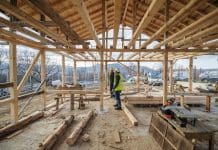The UK Infrastructure Transitions Research Consortium (ITRC) has developed methods to reveal a series of sustainable insights for the Oxford-Cambridge Arc – one of the UK’s largest housing and transport projects
The Oxford University-led Infrastructure Transitions Research Consortium (ITRC) has created unique methods for simulating future population, housing growth and demand for infrastructure services throughout the Oxford-Cambridge Arc.
The methods explore how the necessary infrastructure can be provided affordably, securely and sustainably.
A report on the method provides an analysis of key questions including travel time, carbon footprint, water usage, housing developments, pollution and environmental impact.
It found that careful planning for new settlements could allow for development whilst still protecting greenbelt land and other natural habitats, as well as better management of energy and water, and a lower carbon footprint than with unplanned scenarios.
The Oxford-Cambridge Arc findings include:
- Expansion and development of new settlements could result in 5.4 million and 6.1 million people respectively living in the Arc area by 2050
- Planned road expansions may initially generate travel time savings, but are insufficient to prevent travel time increases in the longer term
- To address travel time, additional steps must be taken to manage demand for road travel and reduce congestion
- The vision of a carbon-neutral Arc is achievable but the greatest challenge is how to heat buildings with renewables
- Insulation and energy efficiency solutions should be implemented first, followed by low-carbon heat technologies
- Water use in the Arc is predicted to double by 2050, and reuse schemes could aid in meeting demand
- The development of a new cities scenario could result in doubling the risk of water shortages
- A ‘Green Arc’ vision could be developed to preserve the Arc’s natural environment
- The development must preserve and integrate existing natural capital assets and create green corridors for people and wildlife.
Jim Hall, director of the ITRC and professor of climate and environmental risks at the University of Oxford, said: “The Oxford-Milton Keynes-Cambridge Arc is the most far-reaching housing and transport development proposed in recent decades, akin to a British Silicon Valley.
“One million new homes could be created by 2050, along with a new road Expressway, a new rail link and new and innovative forms of urbanisation.”
The UK’s National Infrastructure Commission (NIC) made recommendations in its 2017 report to develop the Arc as a knowledge-intensive economic cluster.
However, ITRC says there is currently a challenge around the Arc’s implementation as local authorities and Government have lacked independent systemic analysis due to the complexities of planning for such a complex project.
The ITRC approach aims to fill that gap and helps inform decision-making at all scales.
A pioneering tool for the Arc
ITRC is applying its models and analytics to explore possible futures for the Arc, evaluating and quantifying the impact of local and national choices on sustainable future options.
The ITRC’s Arc studies bring together data on the whole range of infrastructure that would be required, along with population modelling and forecasts energy, transport, water and digital communications requirements.
Hall added: “ITRC’s modelling will help to create a clear vision for the Arc’s grey and green infrastructure, employment and housing. The tool is highly flexible and can analyse a multitude of different scenarios at varying scales.
“Built well, infrastructure can demonstrably and positively contribute in areas from economic prosperity and employment to health, education and the safeguarding of the planet’s natural resources.”
The ‘system of systems’ approach pioneered by ITRC means it can model a cross-sectoral approach to developments.
Professor Hall commented: “This means investments in infrastructure can be properly costed, planned for long-term sustainability and resilience to natural hazards, and looked at from a systems perspective rather than on a project-by-project basis.”
This approach could also be used to identify complexities such as how failure in one network or area might impact on another, such as massive floods across a city on transport, businesses and homes.

















